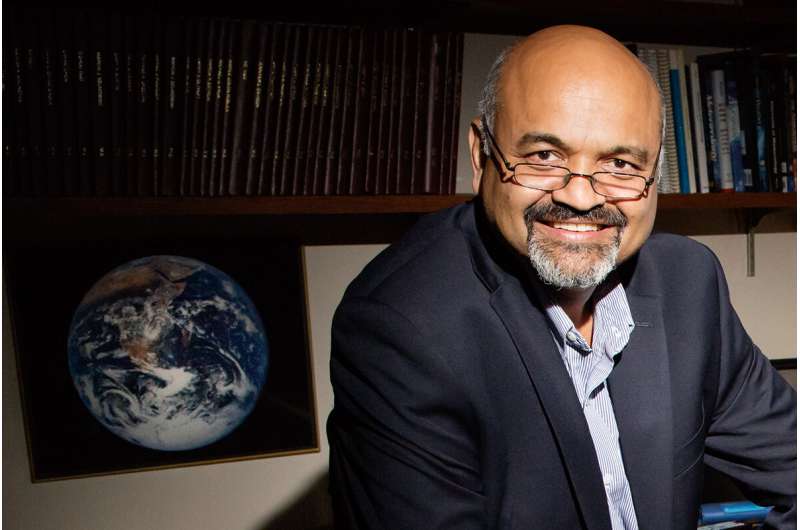Expert discusses the global carbon budget

The Global Carbon Project recently released its 2019 annual report, giving decision-makers access to data on atmospheric carbon concentrations, emissions and trends. Illinois atmospheric scientist Atul Jain is among the many scientists worldwide who contributed data to the report. News Bureau physical sciences editor Lois Yoksoulian spoke with Jain about this year's findings.
What is a global carbon budget and how is it prepared?
The Global Carbon Project publishes its report each year incorporating data from multiple research institutes around the world on carbon dioxide emissions and their redistribution among the atmosphere, ocean and land biosphere. A budget estimate is important to better understand the global carbon cycle, support the climate policy process and project future climate change.
The Global Carbon Budget 2019 has 76 co-authors from 15 countries and 59 institutions. It is published in a living data format, meaning that it is constantly evolving, and provides the highest transparency and traceability in reporting of this set of key indicators and drivers of climate change.
What does the report suggest about the CO2 emissions for 2019 and the trend over the past years?
The global CO2 emissions are expected to rise more slowly in 2019. Emissions from burning fossil fuels are projected to grow by 0.6 percent this year to reach almost 37 billion tons of CO2. This projection is down from 2.1 percent in 2018 and 1.5 percent in 2017. We cannot rule out a decline in global emissions in 2019, given uncertainties in the projection.
Forest fires also have driven CO2 emissions up in 2019: 6 billion tons of CO2, about 0.8 billion tons more than the last year, driven partly by fires in the Amazon and Indonesia.
What factors are contributing to the slower growth rates in fossil emissions in 2019?
The lower growth rate in emissions in 2019 is due to various factors, including substantial declines in coal use in the United States and the European Union; weaker economic growth and lower growth in electricity demand in China; weaker economic growth combined with a strong monsoon in India; and weaker overall economic growth globally.
Where does the U.S. fit in as a contributor? Could that change, and, if so, why?
U.S. emissions are projected to decrease by 1.7 percent in 2019, with a large (–10.5 percent) decline in coal use emissions. There are several reasons for these reductions, but the major one is the displacement of coal consumption by natural gas, and to a lesser extent by solar and wind power. The U.S. coal industry is declining because of the lower cost of natural gas. As a result, utilities are accelerating their retirement of coal plants.
Many other factors contribute to the decline in U.S. emissions, including a large increase in solar and wind power, a reduction in industrial energy use and changes in transport patterns. It is interesting to note that despite a strong U.S. economy over the past year, declines in U.S. emissions have persisted. I expect many of these factors will continue to reduce emissions. However, the rate of reduction may slow down in the coming years.
Are there any changes in how the GCB data is presented this year?
In this year's report, each of our regional projections contains separate projections for coal, oil, natural gas, cement and other smaller components. The separate projections allow, for the first time, consistent projections of global emissions by both countries and by fuel type. For example, the global fossil CO2 emission projection of +0.6 percent includes separate global projections of the emissions from coal (-1.1 percent), oil (+0.9 percent), natural gas (+2.5 percent) and cement (+3.7 percent).
What changes in the past year or ongoing trends are most concerning, in your opinion?
My major concern is that CO2 emissions this year are likely to be 4 percent higher than in 2015, the year of the United Nations Paris Agreement. Despite a predicted decline in coal use in 2019, coal is still the main source of CO2 emissions, accounting for about 40 percent of fossil fuel emissions. In addition, natural gas emissions have been growing steadily for over half a century. In 2019, natural gas has had the fastest fossil fuel emissions growth, with a projected increase of 2.5 percent. Unfortunately, the growth in low carbon technology (e.g., solar, wind) has so far been too low to offset the growth in fossil energy.
I also am concerned about the increasing amount of wildfire activity during summer due to global warming in many regions of the Northern Hemisphere, such as the western U.S., Europe and Siberia. These fires emit CO2 and other greenhouse gases into the atmosphere that will continue to warm the planet well into the future.
Moving forward, what is something that you think can help us to control climate change?
In my opinion, education, even at the middle and high school level, can play a key role in combating climate change. As an educator, I get a sense that teaching the facts about climate change can play a role in making children aware of factors that drive climate change and about the key approaches and technologies to adapt to the impacts of climate change. Increased climate literacy among young people may also help them make informed decisions about adaptation and mitigation options available to them for sustainable lifestyles.
Provided by University of Illinois at Urbana-Champaign




















